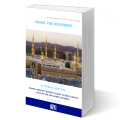
Hagia Sophia, lovingly referred to as Aya Sofya, is an architectural marvel with an awe-inspiring history that spans over an astonishing 1600 years. Situated in the heart of Sultan Ahmed, Istanbul, this iconic mosque is not merely a religious monument but a living testament to the enduring legacy of human creativity and faith.
Originally, Aya Sophia served as a Greek Orthodox Christian patriarchal cathedral in an era when Istanbul bore the name Constantinople, acting as the majestic capital of the Byzantine Empire. This cathedral was an embodiment of architectural grandeur and spiritual significance, a place where emperors were crowned, and the faithful gathered to partake in divine worship.
The construction of Hagia Sophia is a remarkable chapter in architectural history. The Hagia Sophia that we see today marks the third iteration of this sacred site. Emperor Justinian, during his reign from 532 to 537, presided over its construction, commissioning the finest architects and craftsmen of the time to bring his vision to life. The result was nothing short of breathtaking—a structure that seamlessly blended innovation and tradition, captivating all who beheld its splendor.
However, Hagia Sophia’s story takes a tumultuous turn in the annals of history. In 1204, during the Fourth Crusade, the cathedral fell victim to an unfortunate turn of events. Catholics, under the guise of religious fervor, ransacked its treasures and pillaged its sacred halls, resulting in immense loss and desecration. This painful episode serves as a stark reminder of the complex interplay between faith, power, and human actions in history.
In addition to these historical challenges, Hagia Sophia has endured the unpredictable wrath of nature, facing numerous devastating earthquakes over the centuries. These seismic events tested the resilience of this magnificent structure, yet it miraculously withstood the forces of nature.
Today, Hagia Sophia stands not only as a mosque but as a symbol of Istanbul’s rich and diverse heritage. It is a place where the echoes of emperors’ footsteps still resonate, and the spirit of devotion continues to inspire. Its timeless beauty and historical significance make it an essential destination for those seeking to explore the intricate tapestry of Istanbul’s past.
As visitors step through its doors, they are transported through time, immersing themselves in the captivating story of Hagia Sophia—a monument that has weathered the storms of history and emerged as an enduring testament to human achievement and spiritual resilience.
Aya Sophia’s Transformation into a Mosque (1453):The Ottomans captured Constantinople in 1453, marking the end of the Byzantine Empire.
Sultan Mehmet the Conqueror celebrated victory by converting the Basilica of Saint Sophia into a mosque, renaming it Aya Sofya.
Friday prayers under its iconic domes solidified its role as a mosque.
The Iconic Minarets:
Over time, four majestic minarets were added to Aya Sophia by successive sultans: Mehmet II, Beyazit, and Selim II.
These minarets gracefully punctuate the Istanbul skyline, enhancing the mosque’s grandeur.
Aya Sophia as a Museum (1935):
After the fall of the Ottoman Empire and the establishment of the Republic of Turkey, Aya Sophia continued to serve as a mosque until 1931.
In 1935, it was transformed into a museum, opening its doors to history enthusiasts and art lovers.
Today, it is proudly recognized as the second most visited museum in Turkey, welcoming over 3.3 million visitors annually.
A Remarkable Reconversion (2020):
The Blue Mosque, a renowned Muslim place of worship in Istanbul, stands in awe-inspiring proximity to Hagia Sophia.
In 2020, Hagia Sophia underwent a significant transformation, reclaiming its original status as a mosque.
Muslims once again gather under its storied domes, marking a historic return to its spiritual roots.
Aya Sophia’s journey from a Byzantine cathedral to an Ottoman mosque, followed by its role as a museum, and its recent reversion to a mosque, reflects the vibrant tapestry of history that Istanbul embodies. It remains a symbol of unity between the East and West, inviting millions to marvel at its architectural splendor and contemplate the enduring significance of faith and culture. Aya Sophia continues to be an iconic landmark that transcends time, inviting all to explore its multifaceted history and the profound stories it holds within its walls.
Read more: Great Mosque of Xi’an
The Al-Dirassa Institute provides a range of online courses in Arabic, Quran, and Islam tailored for non-Arabic speakers. To enroll in our courses or learn more, please don’t hesitate to get in touch with us today.
Discover the experiences of our delighted clients who have thoroughly enjoyed utilizing this standout feature.
Alhamdulillah I‘m very pleased with the arabic and Qur’an lessons I receive from teacher Umm Tasneem and I‘m also content with the al-dirassa administration team who were very quick in answering any questions I had. In a month I progressed a lot and I cannot wait to continue my studies with al-dirassa. May Allah reward everyone at al-dirassa.
Verified review - view original
My Qur’an teacher is fantastic, she teaches me in a loving and kind way where I look forward to the lessons and learn so much. My Arabic teacher is equally as nice and has a lot of patience with me, she has great expertise in the field and I’ve progressed really quickly with her. Thank you Al-dirassa!
Verified review - view original
Don’t want to go through the translation anymore?
30 free minutes with your qualified Egyptian teacher.

Al-dirassa Institute offers you a gift to help you begin your journey to being fluent in Arabic and learning the Quran.

Al-dirassa Institute offers you a gift to help you begin your journey to being fluent in Arabic and learning the Quran.